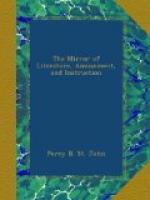The entrance is from the great road through a fine gateway, having on each side an open colonnade, and on the top a lion passant, the crest of the noble house of Northumberland. A flight of steps leads into the great hall, sixty-six feet by thirty-one feet, and thirty-four in height, paved with white and black marble, and ornamented with colossal statues, and an extremely fine bronze cast of the Dying Gladiator, cast at Rome, by Valadier. A flight of veined marble steps leads to the vestibule, with a floor of scagliola, and twelve large Ionic columns and sixteen pilasters of verde antique. This leads to the dining room, ornamented with marble statues and paintings in chiaro oscuro, after the antique, with, at each end, a circular recess, separated by Corinthian columns, fluted, and a ceiling in stucco, gilt. The drawing room has a rich carved ceiling; and the sides are hung with three-coloured silk damask, the finest of the kind ever executed in England. The antique mosaic tables, and the chimney-piece of this apartment are very splendid, as are also the glasses, which are 108 inches by 65. The great gallery, serving for the library and museum, is 133-1/2 feet by 14, is in stucco, after the finest remains of antiquity, and is remarkable as the first specimen of stucco work finished in England. A series of medallion-paintings here represents the portraits of all the earls of Northumberland, in succession, and other principal persons of the houses of Percy and Seymour. At each end is a little pavilion, finished in exquisite taste; as is also a beautiful closet in one of the square turrets rising above the roof, which commands an enchanting prospect.
From the east end of the gallery is a suite of private apartments leading back to the great hall, and hung with valuable paintings, among which are the following portraits: Henry Percy, ninth Earl of Northumberland, who was implicated in the Gunpowder Plot, and imprisoned in the Tower; he died November 5, 1632, the anniversary of the day so fatal to his happiness. Lucy, Countess of Carlisle, his daughter, one of the most admired




